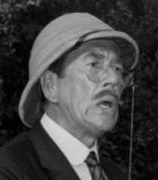|
E: Talking about D. B. Cooper here. Some of the case seems to have been very carefully thought out (choice of aeroplane) and some just moronic (jumping into Washington's forests in winter when you can't even spot a real parachute). Even if you survived the jump you'd never survive the cold. Safety Biscuits has a new favorite as of 10:58 on Jul 13, 2016 |
|
|
|

|
| # ? Jun 5, 2024 10:02 |
|
Give the guy a break. Everyone makes mistakes, especially when they're stressed out.
|
|
|
|
Perhaps this is a case for reddit.
|
|
|
|
Right, because they did such a bang up job with the Boston bombing. (they legit hosed up the FBI investigation)
|
|
|
|
flosofl posted:Right, because they did such a bang up job with the Boston bombing. The best part was when they harassed the family of a missing BU student because they made a facebook page full of his childhood pictures begging him to come home or call them. The pictures were all a code to coordinate bombings, you see. A week later they found the kid's body in a river. He had killed himself and was dead the whole time.
|
|
|
|
Crow Jane posted:DB Cooper is Don Draper, everyone knows that. No, D.B. Cooper was Adam West.
|
|
|
|
Jack Gladney posted:The best part was when they harassed the family of a missing BU student because they made a facebook page full of his childhood pictures begging him to come home or call them. The pictures were all a code to coordinate bombings, you see. I lived in Providence at the time and there were missing signs for weeks beforehand. It was horrible seeing friends of the kid dealing with it all.
|
|
|
|
House Louse posted:E: Talking about D. B. Cooper here. Maybe jumping into Washington's forests in winter was also carefully planned out and he has preparations within preparations we'll never know.
|
|
|
|
Axeman Jim posted:Part 2. Saturation, Carelessness and Error. The iron lockout collars surprised me. I didn't realize people were hip to physical lockouts that far back. Nice to see they were treated with as much disdain as they receive now!
|
|
|
|
Part 3 – Inferno The massive, double-headed troop train smashed head-on into the stationary Local service at about 60mph. Wreckage from the two trains flew in all directions, smashing into the two stationary freight trains in the loops. Seconds later, the Northbound express, that the Local had been shunted to allow to pass, came screaming out of the fog at top speed and ploughed into the wreckage, making five trains in total contributing to the carnage. Such was the violence of the two impacts that the troop train was reduced in length from 195m to 61m.  The impact killed dozens, but worse was to come. The coal-gas tanks feeding the antiquated lighting system of the troop train ruptured and were ignited by the fireboxes of the six wrecked locomotives, and the wreckage of all five trains was engulfed in flames within seconds. The fire was so intense that the coal from the tenders of the six locomotives was all consumed.  Being early in the morning, the express and the local were lightly loaded, and the crews of the two freight trains were in the signalbox. But the 500 soldiers packed into the troop train were not so lucky. Many were trapped and wounded in the burning wreckage, and others were locked into the wooden carriages, which became cauldrons of flaming panic, the screams of the dying and the doomed every bit as bad, or worse, than what would have awaited them on the Turkish front. Ammunition stored in the back of the train ignited and exploded, showering the wreckage in shrapnel. The remote location meant long delays in rescue services reaching the wreckage, and for several hours the victims were left to pretty much fend for themselves. Multiple eyewitnesses confirmed that some army officers walked around the burning carriages, shooting dead wounded and trapped soldiers to put them out of their misery. This would be one of many disturbing aspects of the case that would never find its way into any official reports. The local fire and ambulance response from Gretna arrived and was completely overwhelmed by the scale of the catastrophe, the resources of the small town nowhere near enough to deal with a blazing five-train pileup and hundreds of casualties. Without proper medical equipment, desperate measures were called for, and some men had trapped limbs swiftly amputated with bayonets without anaesthetic to free them before the flames claimed them. Even when crews from Carlisle and Lockerbie eventually arrived, the fire was so intense that they had little choice but to let it burn itself out. The response focused on laying out the dead and wounded, and soon the field by the side of the tracks became an open-air morgue.  So devastating was the fire that the official figure of 226 dead is at best a conservative estimate. The only copy of the regiment’s roll was on board the train and was incinerated. The fire was so ferocious that many bodies were reduced to ash and could not even be counted, much less identified. And of course it is more than probable that some surviving soldiers took the opportunity to slip away and desert, knowing that they would be presumed dead. The bodies of four children were recovered but never claimed, possibly because they lost their entire families in the disaster. The bodies of the soldiers that could be found were buried three-deep in a mass grave with military honours. Only 83 bodies were ever positively identified. What is known was that that half the Battalion was wiped out in the crash, with hundreds more wounded. Only 65 of the 500 men who set off that morning were fit enough to attend roll call that afternoon – an attrition rate that not even the worst of the Somme or Gallipoli could equal. The newspapers were not slow to pick up on the irony:  The survivors, traumatised and burned, some missing limbs, were taken to Liverpool where Army top brass hurriedly attempted to put them on ships for Gallipoli, hoping that the Ottoman Empire would silence them better than the impending cover-up ever could. But medical officers in Liverpool declared all of them medically unfit to serve and put them on trains back to their barracks – straight through the site of the disaster. The effect of all this on the men’s mental health could only be guessed at, but by the time they arrived back at their barracks, they were in such an appalling physical state that local children mistook them for prisoners of war and pelted them with stones. Even by the standards of a nation engaged in total war, the disaster at Quintinshill was shocking. The papers immediately began asking questions. The government and the rail companies, sensing harm to the war effort and the bottom line, urgently set about ensuring that they were never answered. Next: Part 4 – Conspiracy and Cover-Up
|
|
|
|
outlier posted:Since none of the money was ever spent*, I'm tilting towards him dying in the fall or shortly afterwards which eliminates most suspects. But it's amazing how many half-decent candidates there are. It really depends on where he spent the money or what connections he had in different places. It was a lot easier to smuggle large amounts of cash out of the country back then and international travel to lots of places we heavily scrutinize in the modern era (especially by private plane) was a loving free for all. The whole joke about declaring your 10 grand and then taping the rest of it to your body was a very real thing, although you could usually fly with it barely concealed depending on where you were flying to. All he would have had to do (if he survived the jump, a huge if but honestly not as big as some people make it out to be) was fly to one of a half dozen places and get the money exchanged for local currency and then exchanged back, he would have lost cash depending on where he went but not much. It was very easy in the 70's to go to Hong Kong or Columbia and get your money cleaned. It was essentially as simple as getting all your cash exchanged at one bank for the local currency and then getting it converted back at a separate bank and with how many banks in those places dealt in crime the chance that any more than a handful of bills would have ended back in circulation in the US was basically nil with how relatively small the amount of money it was (some banks in Columbia in the 70's and 80's cocaine boom were literally handling hundreds of millions of dollars in cash in a single day, sometimes in an hour). Identity theft in the pre-1990's world was also super simple and required you to be not an idiot and make maybe a dozen phonecalls at most, the fact that more people didn't disappear and so many got caught is actually shocking. But at the end of the day currency tracking was only really in use in large metro areas at the time, if he was from near where he jumped (rural Washington or Oregon) 100k is a vast amount of money for one man to just have at the time but also a vastly small amount of money to track down in a place that was very behind the times and relied on poor and out dated banking systems. I'm from rural Oregon, that area in the 1970's was still extremely wild west, full of nazis, separatists, drug farmers and white nationalists, there would have been ample ways to make a lot of money disappear or turn into slightly less clean money. WickedHate posted:Maybe jumping into Washington's forests in winter was also carefully planned out and he has preparations within preparations we'll never know. This point is actually up for debate, a lot of people including one of the original investigators thinks he probably bailed out over the lower Washougal which is actually a pretty good place to land a parachute, these days it's pretty developed but back then it was mostly sparsely forested fields, farms and grazing land. It would have been in the high 40's and he would have landed pretty close to civilization (probably an hour or two's walk to one of a few small towns). So if things had gone well survival wouldn't have been out of the question assuming he didn't break one of his legs on the landing. There's been enough land development in that area that he probably would have been found if he hit a tree or something. The actual and probable death is that he landed in the Washougal itself or the Columbia in which case the money that did get found is probably the only bit of it we'll find and we may never find his body unless someone is dredging for something else and pulls it up by accident. Edit: I'm personally a proponent of the theory that he was probably a former Canadian paratrooper who had retired from the RCAF to work in civilian or military aerospace and was probably located in the Pacific Northwest or British Columbia. A lot of the evidence would point towards that, the issue with that theory is that it means the suspect pool is pretty loving small so it would be kind of odd if he hadn't been identified yet. El Estrago Bonito has a new favorite as of 10:41 on Jul 15, 2016 |
|
|
|
Part 4: Conspiracy and Cover-Up The judicial response to the disaster was multifaceted, and it was Meakin and Tinsley who were to be the fall guys. The first enquiry was by the British Board of Trade, the regulator for the railways in the guise of the Railway Inspectorate. Lt Col Druitt was unequivocal in blaming the two signalmen for the disaster in every aspect. He dismissed concerns about the fire safety of the requisitioned coaches with the rather bizarre reasoning that they would have caught fire anyway even if they weren’t lit by gas. The fact that not every other collision on the railways resulted in a 12-hour conflagration and hundreds of deaths seemed not to concern him. He also dismissed claims that the signals on huch a high-speed stretch of the main line should have been electronically interlocked (which even back then was standard practice in many places) by saying that the visibility from the signalbox was good enough to use if the signalmen had abided by the regulations. Despite the accident occurring in Scotland, the British Home Office ordered that a coroner’s inquest take place in England on the grounds that some of the victims had died in hospital South of the Border (for those that don’t know, Scotland has a separate legal system to the rest of the UK). This inquest, of dubious jurisdiction, was swift in deciding that the deaths were due to gross negligence on the parts of Meakin and Tinsley, and the English Director of Public Prosecutions announced criminal manslaughter charges against the two men. At the same time, his Scottish equivalent, the Procurator Fiscal, announced that charges would also be brought under the equivalent Scottish offence of Culpable Homicide. This marked the very first time in the 300-year history of the United Kingdom that anyone had been charged with the same offence in both jurisdictions at the same time, and demonstrated just how keen the authorities were to get their scapegoats. Eventually it was decided to go ahead with just the Scottish trial. The trial was a farce. Presided over by the Lord Justice General (Scotland’s most senior judge) and prosecuted by the Lord Advocate (Scotland’s most senior lawyer), the two men’s solicitor did not even call any witnesses in their defence, nor did either man take the stand. After deliberating for only eight minutes the jury found them guilty of all charges.  Something like this, basically Tinsley was sentenced to three years, Meakin to eighteen months, but both had been released from prison within a year. Surprisingly, both found jobs back with the same railway whose customers they had been criminally convicted of killing, working quietly in unobtrusive jobs until they retired. In the midst of the Great War, both men were forgotten. Convenient for them, convenient for the Caledonian, convenient for the government and the military. There has long been the whiff of conspiracy about the trial of Meakin and Tinsley. Their swift conviction and lack of defence against the charges removed the need for a lot of awkward questions to be answered. Their short sentences and cozy re-employment more than hinted that they had been offered a deal in exchange for their silence. In 2015, to commemorate the 100th anniversary of the worst rail accident in British history, the BBC arranged for a re-investigation into the accident using modern standards of investigation. The results were startling. Firstly, they found Tinsley’s medical records, and discovered that not only did he suffer from a form of epilepsy that impaired his memory, but also that his employers knew about this and kept him working in the signalbox, despite knowing the risk to passengers. Under today’s legal system, this would be enough to press Corporate Manslaughter charges against the Caledonian on its own, and Tinsley would have had a very strong defence against any criminal manslaughter charge. As for Meakin, the re-investigation concluded that whilst he had violated procedure, there was no real causal link between anything he had done and the crash itself, again casting doubt on any prosecution. That wasn't the only question the Caledonian needed to answer. Track circuits (whereby each rail forms half of an electrical circuit that is bridged by a train's wheels, thereby indicating where trains are) were very much a thing even back in 1915, and the Caledonian's excuse that it was not necessary at Quintinshill because of good visibility didn't wash, especially for a high-speed main line with trains swapping tracks, reversing and coming into and out of sidings. The real motivation behind the decision not to circuit the Quintinshill loops was very clearly a financial one, as was the decision to attempt to pass the Local with the Express at a location without adequate safeguards. Not that the government would have emerged unscathed. Its demands to prioritise military traffic played a large part in the disaster too. It had forcibly requisitioned old, unsafe carriages that not even the evil capitalist pigdog private railway companies wanted to use, re-installed gas lighting in them, then locked its soldiers in them. In the modern day, the Ministry of Defence would have faced all manner of Health and Safety and Manslaughter charges, but back then, Tinsley and Meakin conveniently took the fall for everyone. And thus was the worst rail disaster in British history quietly forgotten about. 
|
|
|
|
If you want to read an article about how the prosecuters in a case can work like the defense to railroad a case before it even starts, here's an article about the aftermath of the Tamir Rice shooting.
|
|
|
|
Great write-up Jim. If you're open to suggestions, may I suggest Thirsk 1892 as an incident that would make a modern audience go 'WTF' from a completely different angle?
|
|
|
|
Axeman Jim posted:
How does that work? As soon as one set of wheels shorts between the rails, you're going to get a '1' which doesn't tell you anything other than that 'at some point along this set of rails there is a train car.' Were the tracks subdivided electrically into many individual circuits? Or were they doing some reflectometry wizardry even back then?
|
|
|
|
Madkal posted:If you want to read an article about how the prosecuters in a case can work like the defense to railroad a case before it even starts, here's an article about the aftermath of the Tamir Rice shooting. Everything about this is infuriating.
|
|
|
|
Wiggy Marie posted:Everything about this is infuriating. I thought it was a well-written article, but to each his own. V
|
|
|
|
Phanatic posted:How does that work? As soon as one set of wheels shorts between the rails, you're going to get a '1' which doesn't tell you anything other than that 'at some point along this set of rails there is a train car.' Were the tracks subdivided electrically into many individual circuits? Or were they doing some reflectometry wizardry even back then? Well, the rails themselves are physically subdivided into individual segments of however long a piece of steel they felt like working with, frequently; some tracks are welded at the joins, some aren't, because a train isn't going to notice a half-inch gap. An electron totally will, though. This is guesswork, I'm sorry, I have a sickness
|
|
|
|
Chichevache posted:I thought it was a well-written article, but to each his own. V The article is excellently written! I meant the situation described. Also, everyone read this article, it's worth a read.
|
|
|
|
Or possibly the resistance tells you how long the circuit is.
|
|
|
|
Clarence posted:Great write-up Jim. It'd certainly make me go WTF from a unique angle, I used to live less than two miles away from Manor Farm.
|
|
|
|
Phanatic posted:How does that work? As soon as one set of wheels shorts between the rails, you're going to get a '1' which doesn't tell you anything other than that 'at some point along this set of rails there is a train car.' Were the tracks subdivided electrically into many individual circuits? Or were they doing some reflectometry wizardry even back then? The rails are electrically isolated into sections that match up with signal blocks. For signalling you don't need to know exactly where the train is, only which track section it occupies, one signal per section. Some more recent systems move the block around with the train using all sorts of wizardry, in London the Docklands Light Railway and some tube lines work this way and can run a train every minute.
|
|
|
|
Phanatic posted:How does that work? As soon as one set of wheels shorts between the rails, you're going to get a '1' which doesn't tell you anything other than that 'at some point along this set of rails there is a train car.' Were the tracks subdivided electrically into many individual circuits? Or were they doing some reflectometry wizardry even back then? No, you're right, but for the purposes of railway signalling it's all you need. The actual 'blocks' of track controlled by the signals can be anything from about 1/4 of a mile to a few yards and you only need to know if 'something' is in each block - what it is or where in the block it is isn't neccessary, just that if 'something's in the block, don't let anything else in'. Each block could be turned into a single circuit either by briding the individual rails with short cables and then isolating them from neighbouring blocks with small gaps or wedges of non-conductive material. The Railway Inspectorate were kind of right when they said that Quintinshill didn't necessarily need track circuits - you could see all the points and signals from the box and, as signal boxes go, it was a pretty simple one (one running line in each direction and a passing loop per running line with a cross-over in between the two running lines is a very simple arrangement compared to, say a three-way dual-track junction with one branch hidden by a bridge or a bend, or a terminus station with a dozen or more platforms and even more cross-overs and much more chaotic traffic patterns). But the fact that the accident happened at all clearly proves that you need an extra layer of protection against human error, and that's what the track circuiting could have provided. Had the system been fitted the local train standing on the southbound line would have triggered a warning lamp on the signal box's track diagram and, had Tinsley not noticed this, it would also have locked that line's signal levers at Danger, preventing him from accepting the troop train. The design of the signal box at Quintinshill was also a factor (although only in the sense that it just helped everything go as wrong as it did). The signalman had to stand with his back to the windows to operate the levers or the telegraph, to look at the track diagram or to write in the register book, so he couldn't check on the traffic while setting the signals. The levers were in the middle of the room, with the fireplace, desk, stove and chairs between the levers and the back wall. So the man on duty, standing in position to pull the levers, couldn't see the trains out the window but was face-to-face with anyone else in the signalbox at the time. With everyone in the box that morning chatting about the war, reading the paper and having a cup of tea, it's somewhat easier to understand how Tinsley managed to accept the troop train and completely forget about the local train that he had just stepped off - he's in the middle of an interesting conversation and hasn't got into the 'flow' of his work, the telegraph bell goes and without breaking off his chat he just half-mindedly pulls the levers as he has all the other hundreds of times before, and all that time his back is to the window through which he would have been able to see the three stationary trains, one of which isn't where it was scheduled to be. If you want to see how the Quintinshill site looked in 1915 (with the signal box still there and before the electrification wires), it's covered a couple of minutes into this 1972 BBC documentary. There are some shots of the inside too, showing the rather awkward layout. https://www.youtube.com/watch?v=3s9Ey5VLJr4 BalloonFish has a new favorite as of 01:29 on Jul 16, 2016 |
|
|
|
El Estrago Bonito posted:This point is actually up for debate, a lot of people including one of the original investigators thinks he probably bailed out over the lower Washougal which is actually a pretty good place to land a parachute, these days it's pretty developed but back then it was mostly sparsely forested fields, farms and grazing land. It would have been in the high 40's and he would have landed pretty close to civilization (probably an hour or two's walk to one of a few small towns). So if things had gone well survival wouldn't have been out of the question assuming he didn't break one of his legs on the landing. There's been enough land development in that area that he probably would have been found if he hit a tree or something. The actual and probable death is that he landed in the Washougal itself or the Columbia in which case the money that did get found is probably the only bit of it we'll find and we may never find his body unless someone is dredging for something else and pulls it up by accident. Would an ex-paratrooper jump with a dummy reserve parachute? I think it's clear he wasn't an experienced parachuter, and even if he was he jumped into very cold (-57º, per Wikipedia) winds without protection, at night, and he didn't tell the aircrew what he would do so he didn't know exactly where he was. I think surviving the jump is very unlikely. Even if he did, he might easily come down a long way from where he was planning, and would then likely be hosed if he landed in forest or far from a town. Good posts about something horrible. Thanks.
|
|
|
|
Since the other poster who lived through Hurricane Andrew hasn't posted anything, I'll take my stab at doing such a writeup. Hurricane Andrew, Part 1: Makings of a Storm  During the 30-year period from 1980 to 2010, considered the most reliable period model by the National Hurricane Center of the National Oceanic and Atmospheric Administration, the United States is struck by about twelve notable tropical cyclones every year. Of those twelve, six on average are considered fully fledged hurricanes and three are considered major hurricanes. In 1992, the most devastating - though not the deadliest - hurricane the United States would see until 2005 began innocently enough. Like all Atlantic tropical cyclones, Hurricane Andrew began as an area of low atmospheric pressure over the warm waters off the western African coast towards the end of the summer. Warm water evaporates and cools, forming a storm system over the tropical waters. Most of these storm systems quickly peter out, turning into nothing but wind, rain, and lightning. However, these storm systems sometimes get caught up in the winds blowing westward from Africa, across the Atlantic Ocean.  If a storm system like this forms near the equator, typically nothing of note happens. But if it's far enough away, the Coriolis Effect starts to go to worm on the storm system, creating a rotating storm system centered around an area of low atmospheric pressure. Warm water feeds evaporation and energy up into the storm which falls back down to earth in turn, turning a mundane storm system into a powerful atmospheric engine. A tropical cyclone is born.  By August 1992, the Atlantic storm season had already seen two cyclones, both below the 34 knot (63 km/h) wind speed threshold to be classified as tropical storms and named. Tropical Depression One had hit Florida in April and caused 2.6 million dollars in damage from heavy rainfall, high winds including a tornado, and flooding. Two people died from the storm in Florida, and another two in Cuba. Tropical Depression Two formed in July, but quickly broke up and did no harm. On August 16, 1992, the third tropical depression of the year was detected about 1,630 miles east-southeast of the island of Barbados. By the next day, a decrease in vertical wind shear - up-and-down air movement that can disrupt the engine of a tropical cyclone - and continued feeding on the energy of the warm summer Atlantic started a true circulation pattern in Tropical Depression Three and winds began moving above 34 knots (63 km/h), escalating the storm system from the status of tropical depression to a fully fledged tropical storm. In the United States, the National Hurricane Center in Miami names every tropical storm of the year, and to do so there are six lists of names which rotate every six years and begin with the first letters A — W used, skipping Q and U, and alternating between male and female names. Major storms and hurricanes have their names retired from the list forever. On August 17, 1992, the National Hurricane Center named the official first tropical storm of the year: Andrew. Next: Part 2: Hurricane
|
|
|
|
I want to say thank you to all the amazing write ups on horrible circumstances and disasters. This is extremely my fetish, so to speak.
|
|
|
|
I went through Sandy on Long Island, but I was very fortunate to be in flood zone 4 (minimal danger of flooding) and my dad had filled every gas can we had before the storm so we had a decent reserve of fuel for our generator. That's a good tip actually. If you have a generator and severe weather that may knock out the power is predicted, fill as many cans as you can several days beforehand. Any you don't end up needing can be poured into your vehicle's fuel tank and is none the worse for sitting in cans for a few days. And if the power does go out for an extended period, you will be very happy you have a reserve and don't need to wait for hours or pay inflated prices.
|
|
|
|
pienipple posted:I went through Sandy on Long Island, but I was very fortunate to be in flood zone 4 (minimal danger of flooding) and my dad had filled every gas can we had before the storm so we had a decent reserve of fuel for our generator. Not a good tip for the UK, nervous cunts panic buy, then there is gently caress all left for anyone else
|
|
|
|
djssniper posted:Not a good tip for the UK, nervous cunts panic buy, then there is gently caress all left for anyone else They panic buy here if there's a forecast for more than an inch of snow. God help you if your normal grocery shopping trip falls on that day.
|
|
|
ALL-PRO SEXMAN posted:No, D.B. Cooper was Adam West. Yeah. I thought this was solved.
|
|
|
|
|
House Louse posted:Would an ex-paratrooper jump with a dummy reserve parachute? I think it's clear he wasn't an experienced parachuter, and even if he was he jumped into very cold (-57º, per Wikipedia) winds without protection, at night, and he didn't tell the aircrew what he would do so he didn't know exactly where he was. I think surviving the jump is very unlikely. Even if he did, he might easily come down a long way from where he was planning, and would then likely be hosed if he landed in forest or far from a town. I think he might have been trained to jump in WWII and not have jumped since then. I feel like an experienced jumper or one who was inexperienced would have both chosen the newer chute because it would have stood out as the safest one, the fact that he chose the older one (to me at least) says that he might have received parachute training in the past and he chose that one because it was more similar to the one he had used before. He might not have recognized the dummy parachute because those kind of markings didn't become standardized or used until after he had been trained as well. It's also possible that, no matter what level of training he had, that he just hosed up because he was moving quickly. Everything shows that he was an extremely meticulous planner who was familiar with the area, I suspect what actually happened was that he started using the parts of one of the reserve chutes to strap the cash onto his body (which we know he did) and then when he got to the other one he realized it was a dummy and jumped with it anyways. Either way, if he died in the air he wasn't jumping over a super abandoned area full of dense untraveled forests. Basically the best candidate for around where he would have landed (alive or not) is a housing development now and it's surrounded by fields and several towns, hence why I said I think he probably died on impact (or possibly in the air) when he hit either the Columbia or one of it's tributaries.
|
|
|
|
pienipple posted:I went through Sandy on Long Island, but I was very fortunate to be in flood zone 4 (minimal danger of flooding) and my dad had filled every gas can we had before the storm so we had a decent reserve of fuel for our generator. In Canada we don't really get a lot of devastating hurricanes. On the east coast strong tropical storms are fairly common in autumn. They can cause local flooding and tear up shingles, but they don't tend to flatten neighborhoods like they do in the tropics and southeast US. In 2003, Juan decided to bypass the US completely and make landfall right over Halifax. It killed eight people and cause $200 million USD in damage (that's $340 million Canadian today). Canada, PEI, and Quebec were really not prepared for it as such a storm hasn't really happened before. Juan is now on the retired names list. Five months pass and what happens? Another goddamn hurricane-strength storm hits the Canadian east coast. This time in winter, meaning it brought a fuckton of snow with it. I lived in Newfoundland at the time and thankfully Juan missed us but we did get some of the edge of White Juan. I remember my mom's '92 Silverado being completely buried in the driveway. Not even the antenna could be seen poking through the drift. New Brunswick and Nova Scotia were hit the worst, though. Peak snowfall was about 20cm (8 inches) per hour and mandatory curfews were put in place over a week or so for overnight snow clearing. They ran out of places to shovel the stuff and actually had to receive permission from the Government of Canada to just throw it into the harbors from federal docks. It was a goddamn mess.
|
|
|
|
I've been through hurricanes, tornadoes, downbursts, sandstorms, blizzards, was in a house that was struck by lightning, a drought, and have been swept out to sea by an undertoe. I've collected quite a few of nature's "I'm gonna kill you" cards! Can't wait to get my tidal wave and volcano cards!
|
|
|
|
Solice Kirsk posted:I've been through hurricanes, tornadoes, downbursts, sandstorms, blizzards, was in a house that was struck by lightning, a drought, and have been swept out to sea by an undertoe. I've collected quite a few of nature's "I'm gonna kill you" cards! Can't wait to get my tidal wave and volcano cards! Buddy, maybe you need to return that stolen artifact.
|
|
|
|
Ha, that's not even including all the times I really did almost die. Got knocked out and fell into a pool, knife fight, car accident, hit by a car as a pedestrian (twice), street fight and taking a baseball bat to the head a couple of times, shot at (hanging out with some of my old neighborhood gang members), super bad asthma attack when I was a kid, almost drowning while boogey boarding (waves kept breaking on me and I was being pinned/scraped along a small coral patch), emergency landing through a huge thunderstorm (my brain still thinks I saw lightning cracking around the wings) because our plane was running out of fuel and we didn't have enough to get to another airport, a crazy person shooting up an ice cream place my little league team was eating at (among other places he shot up). Then again I did live in Florida when I was a kid, so that's all just regular old kid stuff.
|
|
|
Mak0rz posted:Peak snowfall was about 20cm (8 inches) per hour and mandatory curfews were put in place over a week or so for overnight snow clearing. How did every single roof not collapse after several hours of this? I know they are designed to take the weight of snowfall but there has to be a limit.
|
|
|
|
|
Solice Kirsk posted:Ha, that's not even including all the times I really did almost die. Got knocked out and fell into a pool, knife fight, car accident, hit by a car as a pedestrian (twice), street fight and taking a baseball bat to the head a couple of times, shot at (hanging out with some of my old neighborhood gang members), super bad asthma attack when I was a kid, almost drowning while boogey boarding (waves kept breaking on me and I was being pinned/scraped along a small coral patch), emergency landing through a huge thunderstorm (my brain still thinks I saw lightning cracking around the wings) because our plane was running out of fuel and we didn't have enough to get to another airport, a crazy person shooting up an ice cream place my little league team was eating at (among other places he shot up). Well, you can't un-molest the tribal shamen's daughter, but maybe if you marry her, they'll take the curse off.
|
|
|
|
Lady Demelza posted:How did every single roof not collapse after several hours of this? I know they are designed to take the weight of snowfall but there has to be a limit. Honestly I have no idea! I'm sure there was significant structural damage, I just never really looked beyond the sparse Wikipedia article. I don't recall any roofs collapsing back in my hometown, but we received a far less intense snowfall.
|
|
|
|
Solice Kirsk posted:Ha, that's not even including all the times I really did almost die. Someone should've filmed a reality show about this Florida Man training camp you went to.
|
|
|
|

|
| # ? Jun 5, 2024 10:02 |
|
Most of those were between the ages of 6-10. There's actually more of them. Up until about 8 years ago I lived a very crazy violence filled life. Good for bar stories! Bad for sleeping.
|
|
|














































